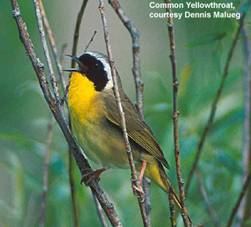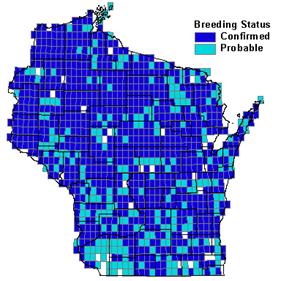

Status/Protection
- Global Rank: G5 Key to global and state ranks
- State Rank: S5B
- WBCI Priority: PIF
Population Information
Federal BBS information can be obtained at http://www.mbr-pwrc.usgs.gov/bbs/bbs.html by clicking on Trend Estimates and selecting the species in question. All estimates are for 1966-2005.
- Federal Breeding Bird Survey: significant decline
- Federal Breeding Bird Survey (WI): significant increase
- Federal Breeding Bird Survey (BCR 23): non-significant increase
- Federal Breeding Bird Survey (BCR 12): significant decline
- Chequamegon National Forest Bird Survey (NRRI): significant decline (1992-2005)
- WSO Checklist Project: stable (1983-2007)
Life History
- Breeding Range: Throughout much of Canada and the central and eastern U.S.; local breeding populations in many western states (Guzy and Ritchison 1999).
- Breeding Habitat: Northern Sedge Meadow and Marsh, Southern Sedge Meadow and Marsh, Open Bog-Muskeg, Emergent Marsh, Wet Mesic Prairie, Wet Prairie, Shrub-Carr, Alder Thicket, Forested Ridge and Swale; shrubby forest edge.
- Nest: Open cup, on or within 10 cm of ground.
- Nesting Dates: Eggs: late May to early July (Robbins 1991).
- Foraging: Gleans, sallies.
- Migrant Status: Short-distance migrant, mid-range migrant.
- Habitat use during Migration: Similar to breeding habitat.
- Arrival Dates: Early to late May (Robbins 1991).
- Departure Dates: Late August to mid-October (Robbins 1991).
- Winter Range: Southern Gulf and Atlantic Coast states, Mexico, the Caribbean, and Central America.
- Winter Habitat: Similar to breeding habitat, but includes forest regrowth, mangrove, and dry scrub.
Habitat Selection
The Common Yellowthroat is a widespread species that exhibits much variation in habitat and microhabitat use throughout its range. Although found in a wide variety of habitat types ranging from wetlands to upland pine forests, it always prefers sites with dense vegetation (Lowther 1993, Stevenson and Anderson 1994, cited in Guzy and Ritchison 1999). In Wisconsin it is expected in marshes, low meadows, open bogs, and wet, grassy fields and pastures (Mossman and Lange 1982, Bohlen 1989, Chen 1993, in Guzy and Ritchison 1999, Hoffman and Mossman 1993, Lowther 1993). In northern Wisconsin, Hoffman and Mossman (1993) found it less common in swamps dominated by conifers or black spruce than in more open bogs. In the same region, Chen (1993, cited in Guzy and Ritchison 1999) found that larger males established territories in bog-conifer communities, while smaller males were found in more grassy vegetation. In Minnesota Hofslund (1959) found the Common Yellowthroat along steep hillsides in habitats drier or more forested than where it usually is found. Within these different habitat types, the Common Yellowthroat generally forages under dense vegetation on or close to the ground (Guzy and Ritchison 1999).
Nests are constructed on or near the ground, often well concealed within a tuft of grassy vegetation (Stewart 1953, Hofslund 1959, Guzy and Ritchison 1999). Higher nests are more typical of those built in wetter habitats or later in the breeding season (Stewart 1953, Hofslund 1959).
Habitat Availability
Of all warblers breeding in Wisconsin, the Common Yellowthroat is the most evenly distributed across the state (Robbins 1991). Elias (1997) found it was one of the ten most abundant birds along the Bad River in extreme northern Wisconsin. Because of its versatility with habitat use, much suitable habitat remains in the state for the Common Yellowthroat. However, loss of wetlands and other preferred habitats in certain areas of the state may impact local populations (Elias 2006).
Population Concerns
Breeding Bird Survey (BBS) data suggest that the Common Yellowthroat population is increasing slightly in Wisconsin (Sauer et al. 2005), where it is a common breeder. During the six-year period (1995-2000) of the Wisconsin Breeding Bird Atlas, observers confirmed breeding activity in 71% of the surveyed quads (Elias 2006). In other portions of its range, the Common Yellowthroat appears to be declining slightly (Sauer et al. 2005). Some local populations, particularly in California and Texas, have declined severely and are in great peril (Guzy and Ritchison 1999).
There are several factors that limit Common Yellowthroat populations. Because it nests close to the ground, it is vulnerable to a wide variety of predators (Guzy and Ritchison 1999). Brown-headed Cowbirds commonly parasitize Common Yellowthroat nests, often resulting in nest failure. Parasitism rates reported include 47.4 % in Michigan (Hofslund 1957), 22 % in Illinois (Graber et al. 1983), and 14.3 % in Minnesota (Hofslund 1959). Common Yellowthroats also are a frequent victim of tower and building collisions during migration. Over a 3-year period in Florida, 2,710 yellowthroats were killed at just one television transmission tower in Florida (Taylor and Anderson 1973).
Recommended Management
The continuation of wetland management, protection, and restoration efforts such as the Wetland Reserve Program and North American Wetland Conservation Act will benefit this species. Management efforts directed at waterfowl and other wetland-associated species will likely benefit Common Yellowthroats (Guzy and Ritchison 1999). Disturbances that create thick vegetative growth, such as timber harvest (Yahner 1993, Yahner 1997, Brawn et al. 2000) and tree die-off from disease (Canterbury and Blockstein 1997), will provide habitat for the short-term.
Research Needs
More research is needed on the breeding behavior, nesting success, and population dynamics of this species. Long-term demographic studies involving marked populations also are warranted (Guzy and Ritchison 1999). In Wisconsin the effects of habitat alteration (drainage, etc.) on this species have not been studied.
Information Sources
- Chequamegon National Forest Bird Survey (NRRI) species account: http://www.nrri.umn.edu/mnbirds/accounts/COYEa2.htm
- Nicolet Northern Forest Bird survey map: http://www.uwgb.edu/birds/nnf/species/COYE.htm
- North American Breeding Bird Survey: http://www.npwrc.usgs.gov
- Patuxent Bird Identification Center: www.mbr-pwrc.usgs.gov/id/framlst/i6810id.html
- Temple S.A., J.R. Cary, and R. Rolley. 1997. Wisconsin Birds: A Seasonal and Geographical Guide. Wisconsin Society of Ornithology and Wisconsin Department of Natural Resources, Madison, WI.
- Wisconsin Breeding Bird Atlas: http://www.uwgb.edu/birds/wbba/
References
- Bohlen, H.D. 1989. The birds of Illinois. Indiana Unit. Press, Bloomington.
- Brawn, J.D., S.K. Robinson, and F.R. Thompson, III. 2001. The role of disturbance in the ecology and conservation of birds. Annu. Rev. Ecol. Syst. 32: 251-276.
- Canterbury, G.E., and D.E. Blockstein. 1997. Local changes in a breeding bird community following forest disturbance. J. Field Ornith. 68: 537-546.
- Elias, J.E. 1997. Avian species richness and abundance levels in different habitats along the Bad River corridor, northern Wisconsin. Passenger Pigeon 59: 21-44.
- Elias, J.E. 2006. Common Yellowthroat. In Atlas of the Breeding Birds of Wisconsin. (N.J. Cutright, B.R. Harriman, and R.W. Howe, eds.) The Wisconsin Society for Ornithology, Inc. 602pp.
- Graber, J.W., R.R. Graber, and E.L. Kirk. 1983. Illinois birds: Wood warblers. Illinois Nat. Hist. Surv. Biol. Notes 118: 21-44.
- Guzy, M. J., and G. Ritchison. 1999. Common Yellowthroat. The Birds of North America, No. 448 (A. Poole and F. Gill, eds.). The Birds of North America, Inc., Philadelphia, PA.
- Hoffman, R.M., and M.J. Mossman. 1993. Birds of Wisconsin’s northern swamps and bogs. Passenger Pigeon 55: 113-137.
- Hofslund, P.B. 1957. Cowbird parasitism of the Northern Yellowthroat. Auk 74: 42-48.
- Hofslund, P.B. 1959. A life history of the Yellowthroat, Geothlypis trichas. Proc. Minn. Acad. Sci. 27: 144-174.
- Lowther, P.E. 1993. Tallgrass prairie I - III. J. Field Ornithol. 64 (suppl.): 103-104.
- Mossman, M. J., and K. I. Lange. 1982. Breeding birds of the Baraboo Hills, Wisconsin: Their history, distribution and ecology. Wis. Dep. Nat. Resour. and Wis. Soc. Ornithol., Madison.
- Robbins, S.D., Jr. 1991. Wisconsin birdlife: population and distribution past and present. Madison, WI: Univ. Wisconsin Press.
- Sauer, J.R., J.E. Hines, and J. Fallon. 2005. The North American Breeding Bird Survey, Results and Analysis 1966 - 2005. Version 6.2.2006. USGS Patuxent Wildlife ResearchCenter, Laurel, MD.
- Stewart, R. E. 1953. A life history study of the Yellowthroat. Wilson Bull. 65: 99-115.
- Taylor, W.K., and B.H. Anderson. 1973. Nocturnal migrants killed at a central Florida TV tower, Autumns 1969-1971. Wilson Bull. 85: 42-51.
- Temple, S.A., J.R. Cary, and R. Rolley. 1997. Wisconsin birds: a seasonal and geographical guide, 2nd edit. University of Wisconsin Press, Madison.
- Yahner, R. H. 1993. Effects of long-term forest clear-cutting on wintering and breeding birds. Wilson Bull. 105: 239-255.
- Yahner, R. H. 1997. Long-term dynamics of bird communities in a managed forested landscape. Wilson Bull. 109: 595-613.
Contact Information
- Compiler: Tom Klubertanz, tklubert@uwc.edu
- Editor: Ron Eckstein, Ronald.Eckstein@Wisconsin.gov | Kim Kreitinger, K.Kreitinger@gmail.com
